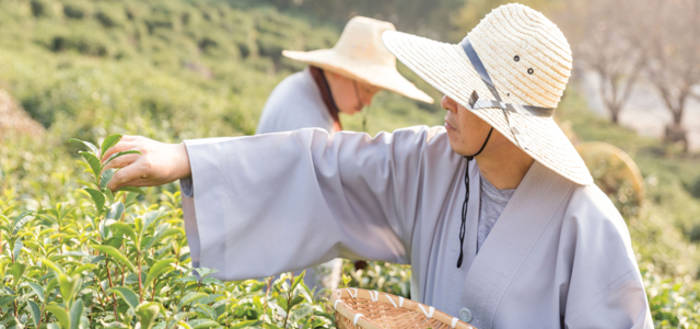Traditional Hadong Tea Agrosystem in Hwagae-myeon, Republic of Korea
Detailed Information
The Hadong traditional tea agricultural system is Hwage-myum residents’ 1200 years of adaptation to the barren environment of the mountainous terrain of Jiri Mountain nature. The local residents preserved their characteristic tea plantation technology and culture uniqueness of this region without spoiling the natural environment which had been passed down from their ancestors. As such, Hadong’s tea agriculture was recognized for its value as Korea’s Important Agricultural Heritage Systems (KIAHS) in 2015.
Food and Livelihood Security
Hwagae-myeon has 91% of its total area composed of steep mountainous land with Seomjin River at its south and Hwagae Stream flowing from north to south, with frequent flood during the monsoon season, both making stable agricultural activities here very difficult. Therefore, the people of Hwagae had to rely on tea agriculture instead of rice paddies to make their living. The people obtained food supply and goods through cultivating indigenous tea trees growing around Hwagae Stream and between rocks in hilly areas around the temples.
During the 1960’s, the traditional tea agriculture of Hwagae-myeon was mostly carried out through the six farming households that owned tea fields. The number of tea-producing households increased to 140 in 1989. Unlike the tea farmers in Korea, Hwagae tea farmers are full-time, devoted professionals of tea agriculture. Hwagae-myeon produces 20% of the total domestic tea production amount of Korea. In 2015, 801 out of 951 (84.2%) of Hwagae rural households work in tea farming, which takes up 40.9% of all tea farming households in Hadong. Hwagae-myeon produces approximately 1,700kg of tea per year, which is 87% of all tea production in Hadong. In Hwagae tea agriculture, revenue is generated mostly through sales of freshly-picked tea leaves and high-quality tea leaves harvested throughout different seasons and processed afterwards.
Agro-biodiversity
The tea fields around Hwagae Stream and the foot of the mountain exist in harmony with the surrounding natural environment, maintaining excellent biodiversity. Species of Hadong traditional tea fields are numerous, including the variety of genes, species, and habitats to house biodiversity. Forests and rivers provide the space in which diverse species of animals and plants indigenous to the Jiri Mountain area can dwell, playing the role of species supply. Hadong tea plants are highly adaptable to the environment due to 1,200 years of habitation in the region while reproducing via insects and wind giving each tea field genetic diversity. Although most tea plants in Hadong are ever green trees belonging to the Theaceae family, which includes species in India, China and Japan, they are therefore more localized with diverse and unique genetic characteristics due to isolation and cultivation in Hwagae area over long period of time.
Local and Traditional Knowledge Systems
Cultivation and Management Method
As Hwagaemyeon had the favorable natural conditions such as climate and soil for growing tea trees, the locals did not need to put in much human effort into managing tea fields. Agriculture of the Hadong tea fields involve minimizing artificial field management methods, only using gaengsin and weed control. Gaengsinis a procedure of organizing the top of tea trees vertically or in the shapes of ovals or arrows. Weed control was traditionally done by pulbibae method, which is picking the weed by hand or putting manure under the tea field after cutting the grass around it. The by-products of branches from gaengsin were spread on the tea fields. The by-products of branches are known to prevent acidification, moisture evaporation and loss of organic matter.
Harvest Method
The tea harvesting methods of Hadong traditional tea agriculture is picking each budding leaf by hand.
Tea Processing Method
The hand roasted tea is a traditional tea made by roasting tea leaves in iron pots with a nice smell and taste. The manufacture method of hand roast can be said to be the traditional tea manufacture method in that it is the same manufacturing method recorded in the Dongsasong of the Choeui Sunsa. Because the Hwage traditional tea field exists between rocks of the mountain foot, cultivating is an arduous task. The tea people of Hadong have basic knowledge of tea manufacture as they pick up at a young age from their parents. They also succeed the manufacture method that has been passed down from the monks of Hwagye Ssangye temples. They also hand down the traditional culture through the research of traditional handmade manufacture method and continuous experience based on what is recorded in Choeui Sunsa.
Cultural and Social Organizations
Hadong-gun, Hwagae-myeon is a representative tea production area of Korea, which was Korea’s first tea field. Hadong, referred to as the home of tea, is the capital of tea culture with various folk songs, poems and songs of our ancestors and people of today. Previously, Hwagae had its tea agriculture managed by monks and later on, it was passed on to the secular in the following centuries. The knowledge system of traditional tea cultivation and processing methods was established and transmitted to the locals by the monks, and it remains until this day. Today, the labor exchange group developed into a joint production and management system for the tea industry from the older cooperative group sharing experience on the hardships of labor and abundance of harvest in the course of preserving and maintaining the traditional tea agriculture.
Landscape Features
It forms the unique scenery in which the tea field is located in harmony with the surrounding forests with the fauna at the slopes—arbors, shrubs, and mosses—and rocks. It is formed without changing any of the mountain area, it maintains the wild beauty and tough appearance of nature. Decorating the tea field displays affection and from early spring when picking starts, the scent of flower spreads. Among the tea areas of Hadong, ‘Eight Beautiful Sites’ was selected to contribute to the spread of tea culture.


